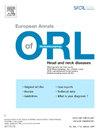Post-treatment monitoring of salivary gland cancer: REFCOR recommendations by the formal consensus method
IF 1.9
4区 医学
Q2 OTORHINOLARYNGOLOGY
European Annals of Otorhinolaryngology-Head and Neck Diseases
Pub Date : 2024-11-01
DOI:10.1016/j.anorl.2023.11.003
引用次数: 0
Abstract
Objective
To determine the frequency and modality of post-treatment monitoring of primary salivary gland cancer.
Material and methods
The French Network of Rare Head and Neck Tumors (REFCOR) formed a steering group who drafted a narrative review of the literature published on Medline and proposed recommendations. The level of adherence to the recommendations was then assessed by a rating group, according to the formal consensus method.
Results
Clinical monitoring should be adapted to the risk of recurrence: initially every 3 months and progressively spaced out, becoming annual after 5 years. Post-treatment head and neck and chest imaging is recommended at 3 months. Local and regional monitoring can then be carried out yearly or twice yearly with contrast-enhanced head and neck imaging. An annual chest CT scan is recommended for high-grade tumors. For lesions at high risk of late recurrence, very prolonged annual surveillance (up to 15 years) is recommended, including screening for pulmonary metastases.
Conclusion
Given the wide range of malignant salivary gland tumors, the modalities and frequency of post-treatment monitoring must be adapted to the expected course of the disease.
唾液腺癌治疗后监测:REFCOR推荐的正式共识方法。
目的:探讨原发性唾液腺癌术后监测的频率和方式。材料和方法:法国罕见头颈部肿瘤网络(REFCOR)成立了一个指导小组,起草了Medline上发表的文献的叙述性综述,并提出了建议。然后,根据正式的共识方法,由一个评级小组评估对建议的遵守程度。结果:临床监测应适应复发风险:最初每3个月一次,逐渐间隔,5年后改为每年一次。治疗后建议在3个月时进行头颈部和胸部影像学检查。然后可以每年或每年两次使用对比度增强的头颈部成像进行局部和区域监测。对于恶性肿瘤,建议每年做一次胸部CT扫描。对于晚期复发风险高的病变,建议延长年度监测时间(长达15年),包括肺转移筛查。结论:恶性唾液腺肿瘤的范围广泛,治疗后监测的方式和频率必须与疾病的预期病程相适应。
本文章由计算机程序翻译,如有差异,请以英文原文为准。
求助全文
约1分钟内获得全文
求助全文
来源期刊

European Annals of Otorhinolaryngology-Head and Neck Diseases
OTORHINOLARYNGOLOGY-
CiteScore
3.70
自引率
28.00%
发文量
97
审稿时长
12 days
期刊介绍:
European Annals of Oto-rhino-laryngology, Head and Neck diseases heir of one of the oldest otorhinolaryngology journals in Europe is the official organ of the French Society of Otorhinolaryngology (SFORL) and the the International Francophone Society of Otorhinolaryngology (SIFORL). Today six annual issues provide original peer reviewed clinical and research articles, epidemiological studies, new methodological clinical approaches and review articles giving most up-to-date insights in all areas of otology, laryngology rhinology, head and neck surgery. The European Annals also publish the SFORL guidelines and recommendations.The journal is a unique two-armed publication: the European Annals (ANORL) is an English language well referenced online journal (e-only) whereas the Annales Françaises d’ORL (AFORL), mail-order paper and online edition in French language are aimed at the French-speaking community. French language teams must submit their articles in French to the AFORL site.
Federating journal in its field, the European Annals has an Editorial board of experts with international reputation that allow to make an important contribution to communication on new research data and clinical practice by publishing high-quality articles.
 求助内容:
求助内容: 应助结果提醒方式:
应助结果提醒方式:


